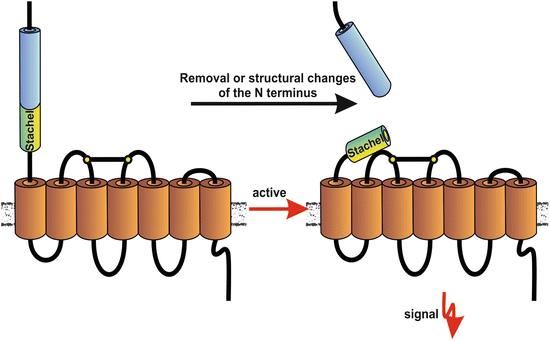Introduction of ADGRB2
ADGRB2, also known as adhesion G protein-coupled receptor B2 or brain-specific angiogenesis inhibitor 2 (BAI2), is a protein encoded by the human BAI2 gene. It is one of three ADGRB sub-family receptors, which are also known as Brain-specific Angiogenesis Inhibitors 1-3 (BAI1-3). Studies have shown that BAI2 has a long N-terminal extracellular region (ECR) containing a GPCR proteolysis site (GPS) adjacent to the seven transmembrane (7TM) domain.
| Basic Information of ADGRB2 | |
| Protein Name | Adhesion G protein-coupled receptor B2 |
| Gene Name | ADGRB2 |
| Aliases | Brain-specific angiogenesis inhibitor 2 |
| Organism | Homo sapiens (Human) |
| UniProt ID | O60241 |
| Transmembrane Times | 7 |
| Length (aa) | 1585 |
| Sequence |
MENTGWMGKGHRMTPACPLLLSVILSLRLATAFDPAPSACSALASGVLYGAFSLQDLFPTIASGCSWTLE NPDPTKYSLYLRFNRQEQVCAHFAPRLLPLDHYLVNFTCLRPSPEEAVAQAESEVGRPEEEEAEAAAGLE LCSGSGPFTFLHFDKNFVQLCLSAEPSEAPRLLAPAALAFRFVEVLLINNNNSSQFTCGVLCRWSEECGR AAGRACGFAQPGCSCPGEAGAGSTTTTSPGPPAAHTLSNALVPGGPAPPAEADLHSGSSNDLFTTEMRYG EEPEEEPKVKTQWPRSADEPGLYMAQTGDPAAEEWSPWSVCSLTCGQGLQVRTRSCVSSPYGTLCSGPLR ETRPCNNSATCPVHGVWEEWGSWSLCSRSCGRGSRSRMRTCVPPQHGGKACEGPELQTKLCSMAACPVEG QWLEWGPWGPCSTSCANGTQQRSRKCSVAGPAWATCTGALTDTRECSNLECPATDSKWGPWNAWSLCSKT CDTGWQRRFRMCQATGTQGYPCEGTGEEVKPCSEKRCPAFHEMCRDEYVMLMTWKKAAAGEIIYNKCPPN ASGSASRRCLLSAQGVAYWGLPSFARCISHEYRYLYLSLREHLAKGQRMLAGEGMSQVVRSLQELLARRT YYSGDLLFSVDILRNVTDTFKRATYVPSADDVQRFFQVVSFMVDAENKEKWDDAQQVSPGSVHLLRVVED FIHLVGDALKAFQSSLIVTDNLVISIQREPVSAVSSDITFPMRGRRGMKDWVRHSEDRLFLPKEVLSLSS PGKPATSGAAGSPGRGRGPGTVPPGPGHSHQRLLPADPDESSYFVIGAVLYRTLGLILPPPRPPLAVTSR VMTVTVRPPTQPPAEPLITVELSYIINGTTDPHCASWDYSRADASSGDWDTENCQTLETQAAHTRCQCQH LSTFAVLAQPPKDLTLELAGSPSVPLVIGCAVSCMALLTLLAIYAAFWRFIKSERSIILLNFCLSILASN ILILVGQSRVLSKGVCTMTAAFLHFFFLSSFCWVLTEAWQSYLAVIGRMRTRLVRKRFLCLGWGLPALVV AVSVGFTRTKGYGTSSYCWLSLEGGLLYAFVGPAAVIVLVNMLIGIIVFNKLMARDGISDKSKKQRAGSE RCPWASLLLPCSACGAVPSPLLSSASARNAMASLWSSCVVLPLLALTWMSAVLAMTDRRSVLFQALFAVF NSAQGFVITAVHCFLRREVQDVVKCQMGVCRADESEDSPDSCKNGQLQILSDFEKDVDLACQTVLFKEVN TCNPSTITGTLSRLSLDEDEEPKSCLVGPEGSLSFSPLPGNILVPMAASPGLGEPPPPQEANPVYMCGEG GLRQLDLTWLRPTEPGSEGDYMVLPRRTLSLQPGGGGGGGEDAPRARPEGTPRRAAKTVAHTEGYPSFLS VDHSGLGLGPAYGSLQNPYGMTFQPPPPTPSARQVPEPGERSRTMPRTVPGSTMKMGSLERKKLRYSDLD FEKVMHTRKRHSELYHELNQKFHTFDRYRSQSTAKREKRWSVSSGGAAERSVCTDKPSPGERPSLSQHRR HQSWSTFKSMTLGSLPPKPRERLTLHRAAAWEPTEPPDGDFQTEV |
Function of ADGRB2 Membrane Protein
Similar to the other two members of the ADGRB subfamily, ADGRB2 is also essential for proper neuronal cell development. It has been reported that the expression of ADGRB2 is specific in the brain, especially at the neurons and astrocytes in the hippocampus, amygdala, and cerebral cortex. Studies have shown that BAI2 has an angiostatic function in the brain by suppressing the expression of vascular endothelial growth factor. The mechanism underlying the 2-dependent regulation of neurogenesis might be based on the binding of the transcription regulator GA-binding proteins α/γ and β/γ to the ICD of 2. In addition, orphan G-protein coupled receptor is involved in cell adhesion and probably in cell-cell interactions. ADGRB2 also has the ability to activate NFAT-signaling pathway which is a transcription factor by the G-protein GNAZ.
 Fig.1 Adhesion GPCRs harbor a tethered agonist sequence.
Fig.1 Adhesion GPCRs harbor a tethered agonist sequence.
Application of ADGRB2 Membrane Protein in Literature
1. Purcell RH, et.al. A disease-associated mutation in the adhesion GPCR BAI2 (ADGRB2) increases receptor signaling activity. Human mutation. 2017, 38(12): 1751-60. PubMed ID: 28891236
This article reveals that the de novo C-terminal mutation (R1465W) in the adhesion GPCR BAI2 has no effect on receptor binding to β-arrestins, but does perturb binding to the endocytic protein endophilin A1. It also provides new insights into the signaling capabilities of the adhesion GPCR BAI2/ADGRB2 and shed light on how an apparent gain-of-function mutation to the receptor's C-terminus may lead to human disease.
2. Speca DJ, et.al. Whole exome sequencing reveals a functional mutation in the GAIN domain of the Bai2 receptor underlying a forward mutagenesis hyperactivity QTL. Mammalian Genome. 2017, 28(11-12): 465-75. PubMed ID: 28894906
This article proves that the R619W mutation in the GAIN domain of the Bai2 receptor is a loss-of-function mutation, which is suggested by expression of Bai2 R619W in two different mammalian cell lines.
3. Zencir S, et.al. Identification of brain-specific angiogenesis inhibitor 2 as an interaction partner of glutaminase interacting protein. Biochemical and biophysical research communications. 2011, 411(4): 792-7. PubMed ID: 21787750
This article reports a new role of BAI2 that can act as an interaction partner of glutaminase interacting protein (GLP).
4. Okajima D, et.al. Brain-specific angiogenesis inhibitor 2 (BAI2) may be activated by proteolytic processing. Journal of Receptors and Signal Transduction. 2010, 30(3): 143-53. PubMed ID: 20367554
This article suggests that BAI2is a functional GPCR regulated by proteolytic processing and activates the NFAT pathway.
5. Jeong BC, et.al. Brain-specific angiogenesis inhibitor 2 regulates VEGF through GABP that acts as a transcriptional repressor. FEBS letters. 2006, 580(2): 669-76. PubMed ID: 16412436
This article reports that BAI2 controls VEGF transcription through GABP under normal conditions and cerebral ischemia.
ADGRB2 Preparation Options
In order to meet every client’s requirements, we have developed advanced Magic™ membrane protein production platform which enables us to provide both reconstitution forms and multiple active formats to obtain functional target proteins. Our professional scientists will work closely with you and help you find a better match for your particular project. Aided by our versatile Magic™ anti-membrane protein antibody discovery platform, we also provide customized anti-ADGRB2 antibody development services.
Creative Biolabs offers a series of membrane protein preparation services for your research needs. Our experienced scientists will do their best to meet every client’s specific requirements. To get more information, please feel free to contact us and get a quote.
All listed services and products are For Research Use Only. Do Not use in any diagnostic or therapeutic applications.